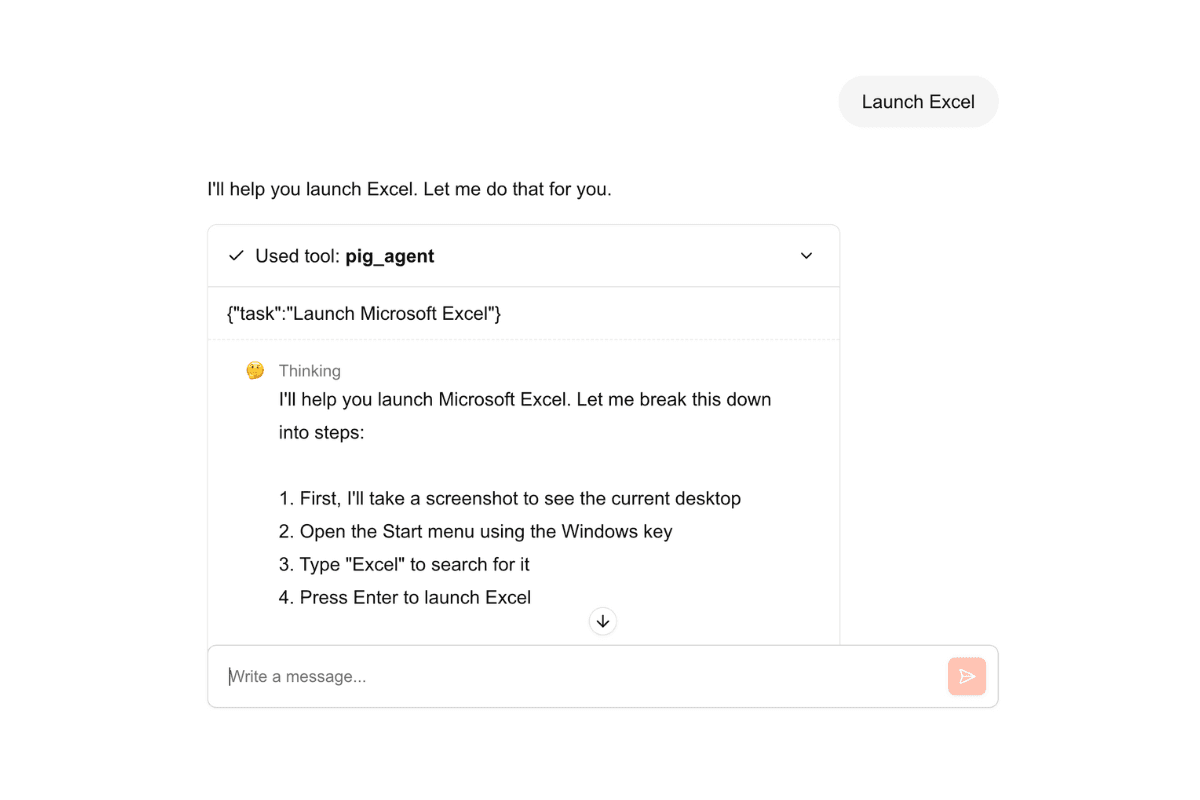An API for automating Windows apps with AI
TL;DR
Pig is an API for automating Windows desktops with AI.
Teams can connect their own Windows machines to Pig, open up a chat, and instruct an AI to perform workflows on that computer, over the internet.
Pig’s agent operates computers as humans would, performing high-value automations that were previously not possible.
The Problem
Many enterprise tools, from electronic health records to manufacturing supply-chain apps, are desktop-based and do not have a public API, preventing automation.
Traditional hardcoded RPA automations can be brittle. Subtle changes in the desktop apps, like popups or slow loading, can derail an automation. And complex workflows which require planning and judgment are not possible.
As a result, human office workers are employed to do highly repetitive tasks, often involving transferring text between different desktop apps, spreadsheets, and emails.
Our Solution
In this example, we show what’s possible building on Pig.
We first connect our own Windows machine using our open-source Piglet computer driver
And then we start an AI chat powered by the Claude Computer-Use model:

The AI is then given high-level tasks, and it begins to work, using Pig’s human-emulating APIs such as:
- Screenshotting the desktop screen
- Clicking at coordinates
- Entering keystrokes
All of which are enough to complete the task.
Pig also provides a developer SDK, allowing teams to build their own agents, manage their connected machines, and send automations to their desktops. Purpose-built agents can be incredibly powerful, so contact us here to talk through custom implementation.
Lastly, Pig includes tools for agents to pass control to human operators during critical operations, such as clicking send on important emails, inputting payment information, or solving captchas.
We intend to be the personal computers for AI, and the embeddable observability window for managers.
Use Cases
Killer use-cases of Pig involve the following factors:
- the workflow requires a Windows desktop app
- The app does not have a public API
I expect to be surprised by what people build on Pig, but I’m most optimistic for use of:
- Office Suite
- Electronic Health Record Software
- Claims Processing Software
- Factory Control Systems
- Lab Software
Team & Background
I’m Erik, a second-time founder, with five years spent building cloud infrastructure.
Most notably, I built Banana, a serverless GPU product used by more than three thousand teams to host production inference jobs.
Prior to Banana, I built a cloud desktop product for accelerating 3D design apps. Following Banana, I had the privilege to work with our former competitor, Modal, on their serverless Python cloud.
Why am I building Pig?
Throughout 2024, I spent my time experimenting with new technologies and building up a thesis for what the future of AI tooling would be. After poking around a few wild ideas (such as data centers in space and internet-over-laser), I boomeranged back to the area that I know and love: compute infrastructure.
An AI founder friend called me up in Nov 2024, pitched me on this idea as something he needed to see in the world, and said, “Erik, you’re the single best founder to build this.”
And I agree. I am.
How to become a user
Pig just launched open and free access to users self-hosting their machines.
Get started today at pig.dev/docs, or contact us for help building custom agents and I’ll reach out!
And if you don’t need Pig, please tell at least one friend about it.
Oink!
Erik
What's the history of your company from getting started until the present day? What were the big inflection points?
- Dec 11: First line of code* Jan 21: Launched serverless VM cloud platform → learned users need to self-host* Feb 16: Launched Piglet computer driver for self hosting → learned implementing agent loops is high friction* Feb 27: Launched Agent layer (chat, soon API) to get users to successful automations faster
What is the core problem you are solving? Why is this a big problem? What made you decide to work on it?
RPA is brittle, and gatekept by consultants who benefit from the need to constantly rewrite automations. For more AI-forward developers building products on top of legacy apps, they have to resort to insecure hacks, like exposing backdoors on their users’ computers, simply to get an automation pushed down it, after which they still must deal with the brittleness inherent to hardcoded automations.I’m deeply excited about this problem because, despite all the change in the world with AI, one thing is for certain: enterprises will keep using Windows.
What is your long-term vision? If you truly succeed, what will be different about the world?
As the global labor output increases tenfold with agents, we’ll be the personal computers they use to interface with the business world.






